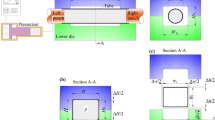Abstract
Large spherical curvature hot forming (LSCHF) process using square grid die was developed to manufacture moss-type LNG tanks. This process commonly realizes less spring-back of the thick plate after hot forming and more productivity than the conventional cold forming. Nevertheless, it is very difficult to shape the plate into a perfectly spherical curvature shape because of the thermal deformation and elastic recovery during cooling after hot forming. The final spherical curvature shape of the thick plate depends on many process variables such as the dimensions of the initial die surface, the size of the grid of the die, and the initial plate and design of the cooling device. In particular, the final spherical curvature shape of the aluminum thick plate is determined by the spherical curvature of the gridtyped die. Thus, the object of this study is to propose a method to design the spherical-curvature of the square grid die. To design the spherical-curvature of the square grid die, a Displacement adjustment (DA) method and a numerical approach by Finite element analysis (FEA) were applied. The die surface design achieved by the DA method and FEA were suggested to adjust the errors in its spherical curvature after final cooling. Finally, an experiment was conducted on a small-scale model (310 × 310 mm) to test the process to verify the design method for the die surface. The FEA results agreed very well with the experiment results within the maximum average errors 0.008% (0.122 mm). Further, the DA method yielded relative errors of 0.011% (0.163 mm) to objective spherical curvature.
Similar content being viewed by others
References
Y. M. Ji, Y. S. Shin, J. S. Park and J. M. Hyun, Study of sloshing flow in rectangular tank, Trans. Korean Soc. Mech. Eng., 35 (2011) 617–624.
S. J. Yoon and D. Y. Yang, Development of a highly flexible incremental roll forming process for the manufacture of a doubly curved sheet metal, CIRP Ann.: Manuf. Technol., 52 (2003) 201–204.
J. J. Anttila, Spherical LNG-tank and a production method for a such tank, United State Patent (1996) No 5,529,239.
S. C. Heo, J. N. Kim, W. J. Song, T. W. Ku and B. S. Kang, Shape error compensation in flexible forming process using overbending surface method, Int. J. Adv. Manuf. Technol., 59 (2012) 915–928.
S. Sanchez-Reyes and J. M. Chacon, Hermites approximation for free-form deformation of curves and surfaces, Comput. Aided Des., 44 (2012) 445–456.
F. Lan, J. Chen and J. Lin, A method of constructing smooth tool surface for FE prediction of springback in sheet metal forming, J. Mater. Process. Tech., 177 (2006) 382–385.
R. Lingbeek, J. Huétink, S. Ohnimus, M. Petzoldt and J. Weiher, The development of a finite elements based springback compensation tool for sheet metal products, J. Mater. Process. Tech., 169 (2005) 115–125.
T. Meinders, I. A. Burchitz, M. H. Bonte and R. A. Lingbeek, Numerical product design: springback prediction compensation and optimization, Int. J. Mach. Tools Manuf., 48 (2008) 499–514.
X. A. Yang and F. Ruan, A die design method for springback compensation based on displacement adjustment, Int. J. Mech. Sci., 53 (2011) 399–406.
W. Gan and R. H. Wagoner, Die design method for sheet springback, Int. J. Mech. Sci., 46 (2004) 1097–1113.
J. M. Lee, I. K. Lee, J. H. Kim, D. S. Kim and B. M. Kim, FEA technique of hot plate forming process using cell-typed die with cooling device, Trans. Nonferr. Metal. Soc., 22 (2012) 831–837.
Author information
Authors and Affiliations
Corresponding author
Additional information
Recommended by Associate Editor Dae-Cheol Ko
In-Kyu Lee received his B.S. degree (2010) in Department of Mechanical and Automotive Engineering from International University of Korea in 2010, and his M.S. degree (2012) in National Core Research Center for Hybrid Materials Solution from Pusan National University in Korea. He is currently a Researcher at the Ultimate Manufacturing Technology Group at Korea Institute of Industrial Technology (KITECH), and Ph.D. candidate of Department of Mechanical Engineering at Pusan National University in Korea. His research interests include cold/hot forging, die design technology.
Byung-Min Kim received his B.S. (1979), M.S. (1984) and Ph.D. (1987) degree from Pusan National University, Korea, in 1979, 1984 and 1987, respectively. Dr. Kim is currently a Professor at the School of Mechanical Engineering, Pusan National University in Busan, Korea. His major research field is production and manufacturing based on metal forming.
Sang-Kon Lee received his B.S. (1998), M.S. (1998) and Ph.D. (2008) from Pusan National University in Korea. Dr. Lee is currently the Chief Officer/Prin- cipal Researcher at the Ultimate Manufacturing Technology Group at Korea Institute of Industrial Technology (KITECH) in Korea. His major research field is metal forming technologies including wire and shape drawing, aluminum/ magnesium extrusion and cold/hot forging process.
Rights and permissions
About this article
Cite this article
Lee, IK., Kim, BM. & Lee, SK. Die design of large spherical curvature hot forming process for improving the dimensional accuracy. J Mech Sci Technol 30, 4315–4324 (2016). https://doi.org/10.1007/s12206-016-0846-6
Received:
Revised:
Accepted:
Published:
Issue Date:
DOI: https://doi.org/10.1007/s12206-016-0846-6




